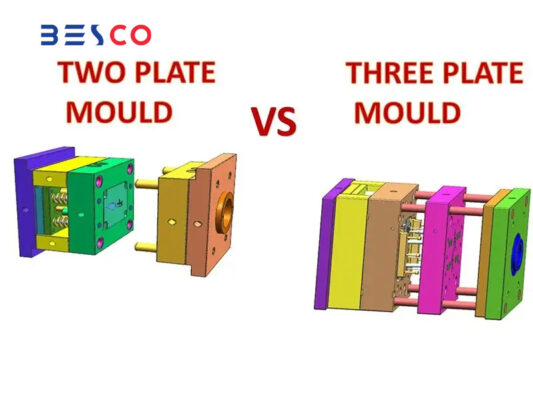What are the main differences between two-plate and three-plate injection molding machines?
Injection molding machines are key tools in the production of plastic parts. Choosing a two plate molding machine or three plate molding machine can significantly affect product quality, productivity, and production costs.
A two-plate injection molding machine occupies less space due to its more compact design and is ideal for producing large parts like car bumpers. These machines provide higher mold clamping force, ensuring part quality.
In contrast, a three-plate injection molding machine is more suitable for producing smaller and more general parts. With a lower initial cost, it’s a more economical option for small businesses.
This article explores the key differences between two-plate and three-plate machines to help you make the best decision for your production line.

1. Design and Structure of the Machines
- Two-plate injection molding machine:
This machine has two main plates that close the mold. Its simple, compact design reduces space usage and complexity.
Key feature: Advanced mold clamping mechanism, allowing for the production of larger and more complex parts. - Three-plate injection molding machine:
Composed of three main components to close the mold, this older design remains popular for producing small to medium-sized parts.
Key feature: Greater flexibility in designing smaller parts.
2. Mold Clamping Force
Mold clamping force is a critical factor in machine selection, as it ensures the mold stays closed under injection pressure.
- Two-plate:
Features a stronger clamping force due to advanced technology in the clamping mechanism, making it ideal for large and heavy parts, such as automotive body parts or industrial components. - Three-plate:
Has a lower clamping force, primarily used for smaller, low-pressure parts.
3. Space Occupancy in the Factory
- Two-plate injection molding machine:
Its compact design requires less space, making it a better option for workshops with limited space. - Three-plate injection molding machine:
Requires more space, making it suitable for workshops without space constraints.
4. Cost and Maintenance
- Two-plate:
Advantages:- Reduced energy consumption
- Lower maintenance costs due to fewer moving parts
Disadvantages:
- Higher initial cost
- Three-plate:
Advantages:- Lower initial cost
Disadvantages: - Higher energy consumption
- Requires more frequent maintenance due to a more complex design
- Lower initial cost
5. Common Applications
- Two-plate:
Ideal for producing large and complex parts, such as car bumpers, dashboards, and industrial components. - Three-plate:
Used for producing smaller, simpler parts such as kitchenware, toys, and general components.
6. Production Speed and Energy Efficiency
- Two-plate:
These machines typically offer higher production speeds and consume less energy than three-plate machines. - Three-plate:
Have lower production speeds and require more energy but remain an economical option for small-scale production.
7. Advanced Technologies in New Machines
Two-plate machines often come equipped with modern technologies, such as advanced digital controls and automation capabilities. These features enhance production accuracy and reduce human error.
Two plate mold vs three plate mold-Which Machine is Right for You?
If you need to produce large, complex, high-quality parts and have limited factory space, a two-plate injection molding machine is the ideal choice.
However, if you’re looking for a more economical option for smaller, general parts and have enough space, a three-plate injection molding machine is a better choice.
Advantages of Two-Plate Injection Molding Machines for Large and Complex Parts
Two-plate molds are often preferred for the production of large and complex parts due to their compact design and simpler structure. These machines offer a stronger mold clamping force, making them ideal for producing heavy, large components such as car bumpers and industrial parts with high-quality results.
The design allows for easy mold closure and requires less space compared to three-plate machines, which is advantageous in production environments with limited space. Additionally, due to lower energy consumption and reduced maintenance needs, two-plate injection molding machines are a cost-effective solution for large-scale production. For more information on the advantages and operation of two-plate injection molding machines, you can refer to this external resource here.
